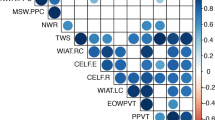Previous twin studies have demonstrated high heritability of specific language impairment (SLI) when the diagnosis is based on psychometric testing. The current study measured the effectiveness of parent and teacher ratings of communication skills in identifying heritable language impairment. The Children’s Communication Checklist was completed by parents and teachers of 6-year-old twins recruited from a general population sample. One hundred and thirty twin pairs (65 MZ) were selected because at least one twin had low language skills at 4 years of age; a further 66 pairs (37 MZ) were a low risk group with no indication of language difficulties at 4 years. Internal consistency, inter-rater reliability, and validity in identifying language impairment were assessed for all CCC scales. CCC scales, especially those assessing structural language skills, were highly effective in identifying cases of language impairment, but agreement between parent and teacher ratings was modest. Genetic analysis revealed negligible environmental influence and substantial genetic influence on most scales. A rater-specific effects model was fit to the data to assess how far parents and teachers assess a common genetic factor on the CCC. Ratings of parents and teachers were influenced to some extent by the same child characteristics, but rater-specific effects were also evident, especially on scales measuring pragmatic aspects of communication. This study shows that there are strong genetic influences on both structural and pragmatic language impairments in children, and these can be detected using a simple checklist completed by parents or teachers.


Similar content being viewed by others
References
Bishop D. V. M. (1998). Development of the children’s communication checklist (CCC): a method for assessing qualitative aspects of communicative impairment in children. J. Child Psychol. Psychiatry 39:879–891
Bishop D. V. M. (2002). The role of genes in the etiology of specific language impairment. J. Commun. Dis. 35: 311–328
Bishop D. V. M. (2002). The Children’s Communication Checklist, version 2 (CCC-2). London: Psychological Corporation
Bishop D. V. M., Baird G. (2001). Parent and teacher report of pragmatic aspects of communication: use of the Children’s Communication Checklist in a clinical setting. Dev. Med. Child Neurol. 43:809–818
Conti-Ramsden G., Crutchley A., Botting N. (1997). The extent to which psychometric tests differentiate subgroups of children with SLI. J. Speech Lang. Hear. Res. 40: 765–777
Dale P. S., Price T. S., Bishop D. V. M., Plomin R. (2003). Outcomes of early language delay: I. Predicting persistent and transient delay at 3 and 4 years. J. Speech Lang. Hear. Res. 46: 544–560
Gathercole S. E., Willis C., Baddeley A. D., Emslie H. (1994). The children’s test of nonword repetition: a test of phonological working memory. Memory 2: 103–127
Gilmour J., Hill B., Place M., Skuse D. H. (2004). Social communication deficits in conduct disorder: a clinical and community survey. J. Child Psychol. Psychiatry 45: 967–978
Geurts H. M., Verte S., Oosterlaan J., Roeyers H., Hartman C. A., Mulder E. J., Berckelaer-Onnes I. A., Sergeant J. A. (2004). Can the Children’s Communication Checklist differentiate between children with autism, children with ADHD, and normal controls?. J. Child Psychol. Psychiatry 45: 1437–1453
Hewitt J. K., Silberg J. L., Neale M. C., Eaves L. J., Erickson M. (1992). The analysis of parental ratings of children’s behavior using LISREL. Behav. Genet. 22: 293–317
Laws G., Bishop D. V. M. (2004). Pragmatic language impairment and social deficits in Williams syndrome: a comparison with Down’s syndrome and specific language impairment. Int. J. Lang. Commun. Disord. 39:45–64
Neale, M. C., Boker, S. M., Xie, G., and Maes, H. H. (1999). Mx: Statistical Modeling, 5th edn. VCU Box 900126, Richmond, VA 23298: Department of Psychiatry
Norbury C. F., Nash M., Bishop D. V. M., Baird G. (2004). Using parental checklists to identify diagnostic groups in children with communication impairment: A validation of the Children’s Communication Checklist - 2. Int. J. Lang. Commun. Disord. 39: 345–364
Posthuma D., Beem A., de Geus, E. J., van Baal, G. C., von Hjelmborg, J. B., Iachine I., Boomsma D. (2003). Theory and practice in quantitative genetics. Twin Res. 6: 361–376
Semel E. M., Wiig E. H., Secord W. (1987). Clinical Evaluation of Language Fundamentals—Revised. San Antonio Texas, Psychological Corporation
Spinath F. M., Angleitner A. (1998). Contrast effects in Buss and Plomin’s EAS questionnaire: a behavioral-genetic study on early developing personality traits assessed through parental ratings. Pers. Ind. Diffs. 25: 947–963
Trouton A., Spinath F. M., Plomin R. (2002). Twins Early Development Study (TEDS): A multivariate, longitudinal genetic investigation of language, cognition and behaviour problems in childhood. Twin Res. 5:444–448
Van der Valk J. C., Van den Oord E. J. C. G., Verhulst F. C., Boomsma D. I. (2001). Using parental ratings to study the etiology of 3-year-old twins’ problem behaviors: different views or rater bias?. J. Child Psychol. Psychiatry 42: 921–931
Wade T., Neale M. C., Lake R. I. E., Martin N. G. (1999). A genetic analysis of the eating and attitudes associated with bulimia nervosa: dealing with the problem of ascertainment in twin studies. Behav. Genet. 29: 1–10
Wechsler D. (1999). Wechsler Abbreviated Scale of Intelligence. San Antonio, Psychological Corporation
Acknowledgments
We thank the twins and their families and teachers who participated in this research. This study would not have been possible without generous assistance of Robert Plomin, Bonamy Oliver, Alexandra Trouton and other staff from the Twins Early Development Study. Thanks are also due to Barbara Arfe and Lesley Bretherton for assistance with data collection, and to Michael Neale for advice on methods of correcting for ascertainment bias. This research was supported by a programme grant from the Wellcome Trust.
Author information
Authors and Affiliations
Corresponding author
Rights and permissions
About this article
Cite this article
Bishop, D.V.M., Laws, G., Adams, C. et al. High Heritability of Speech and Language Impairments in 6-year-old Twins Demonstrated Using Parent and Teacher Report. Behav Genet 36, 173–184 (2006). https://doi.org/10.1007/s10519-005-9020-0
Received:
Accepted:
Published:
Issue Date:
DOI: https://doi.org/10.1007/s10519-005-9020-0




